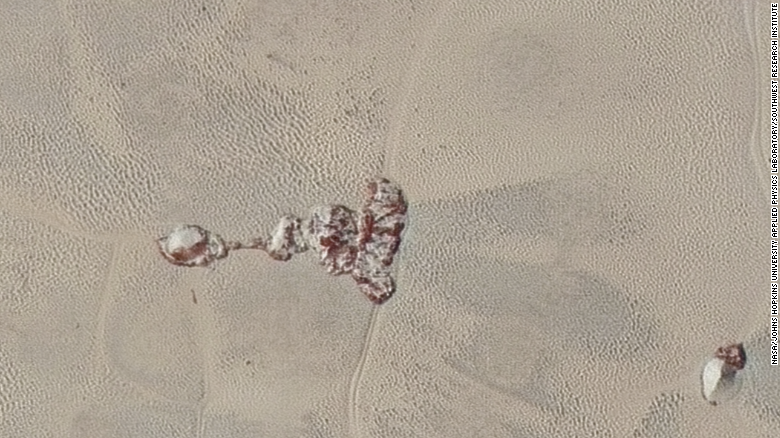NASA provides first image from record-setting flyby of Ultima Thule
Source: CNN
(CNN)The new year on Earth began with a record-setting space mission 4 billion miles away -- a first look at an object on the edge of our solar system.
Mission scientists from NASA and the Johns Hopkins University Applied Physics Laboratory have confirmed that the New Horizons spacecraft conducted a flyby of Ultima Thule, a Kuiper Belt object that's a billion miles beyond Pluto.
Although the flyby occurred at 12:33 a.m. ET on Tuesday, the spacecraft is so far from Earth that the "phone-home" signal didn't reach us until about 10:30 a.m. ET.
Mission scientists were relieved about the success because there was only one chance to get it right as New Horizons screamed past Ultima at 31,500 miles per hour. This incredible feat was possible because thousands of operations on the spacecraft worked in sync.
snip
Read more: https://www.cnn.com/2019/01/01/world/new-horizons-ultima-thule-flyby-success/index.html
this is just incredibly exciting, impressive stuff!
NRaleighLiberal
(60,015 posts)Dennis Donovan
(18,770 posts)...or was it bored thru by ET's? ![]()
![]()
NRaleighLiberal
(60,015 posts)Rollo
(2,559 posts)Duh...
George II
(67,782 posts)NRaleighLiberal
(60,015 posts)going to take 1.5 years for it all to come in!
George II
(67,782 posts).....pixel by pixel that will have to be reassembled. Imagine, four BILLION miles!
KY_EnviroGuy
(14,493 posts)Last edited Wed Jan 2, 2019, 04:09 PM - Edit history (1)
Spacecraft only has a 15 watt transmitter to conserve fuel and Deep Space Network ground station use is shared with many other users.
See: https://eyes.nasa.gov/dsn/dsn.html (New Horizons' ID is "NHPC" )
I just checked the DSN page and New Horizons was transmitting to the Goldstone facility at 841 bits per second. This is a much slower rate than previous events from this mission (see below).
From Johns Hopkins APL:
A major challenge for the New Horizons mission is the relatively low "downlink" rate at which data can be transmitted to Earth, especially when you compare it to rates now common for high-speed Internet surfers.
During the Jupiter flyby in February 2007, New Horizons sent data home at about 38 kilobits per second (kbps), which is slightly slower than the transmission speed was for acoustic computer modems which operated over telephone lines. The average downlink rate after New Horizons passed Pluto (and sent the bulk of its encounter data back to Earth) was approximately 2,000 bits per second, a rate the spacecraft achieved by downlinking with both of its transmitters through NASA's largest antennas. Even then, it took until late 2016 to bring down all the encounter data stored on the spacecraft's recorders.
NASA's New Horizons home page is here: https://www.nasa.gov/mission_pages/newhorizons/main/index.html
APL's mission page is found here: http://pluto.jhuapl.edu/
APL mission summary, technical details on spacecraft powering, and complete technical summary PDFs are found here:
http://pluto.jhuapl.edu/News-Center/Resources.php#Fact-Sheets
As an interesting side note, this mission was almost canceled by W's administration but thank goodness NASA's scientists put up a hell of a fight and got it funded.
..........
reACTIONary
(5,770 posts).... JPL, APL
Johns Hopkins University Applied Physics Laboratory
(I hate it when that happens ! )
KY_EnviroGuy
(14,493 posts)reACTIONary
(5,770 posts).... they can also be "windowed" to crop out dark sky. That helps bost the "effective bit rate".
PJMcK
(22,038 posts)Ultima Thule dates from before the birth of our solar system.
El Supremo
(20,365 posts)
George II
(67,782 posts)NRaleighLiberal
(60,015 posts)LastLiberal in PalmSprings
(12,586 posts)It's a shmoo!

KY_EnviroGuy
(14,493 posts)His Shmoos turned 70 last year!.........![]()
aeromanKC
(3,325 posts)reACTIONary
(5,770 posts)red dog 1
(27,837 posts)A spacecraft taking photos & gathering data on a piece of rock only 10 miles wide and 40 BILLION miles away!
Absolutely amazing!!
PJMcK
(22,038 posts)But you're off by a factor of 10. Ultima Thule is 4 billion miles away, not 40 billion.
justgamma
(3,666 posts)and here I thought it was Pelosi's arrow through Dotard's balls.
PatrickforO
(14,585 posts)This one reminds me of the Courts of Chaos in the old Roger Zelazny Amber Series.
Anyone else remember?

FSogol
(45,503 posts)CCExile
(469 posts)Now, stop it's spin and bring it back!
localroger
(3,629 posts)We need better resolution to resolve that neck, which is pretty thin if it's solid.
reACTIONary
(5,770 posts)Takket
(21,592 posts)
Nitram
(22,840 posts)Kablooie
(18,637 posts)Wonder if it's in love now?
trusty elf
(7,398 posts)
LudwigPastorius
(9,160 posts)
